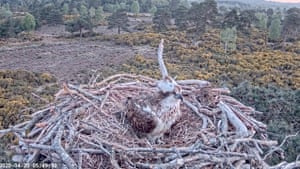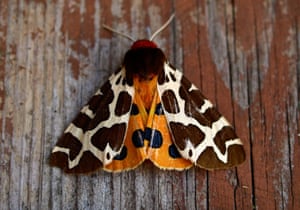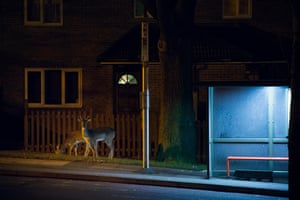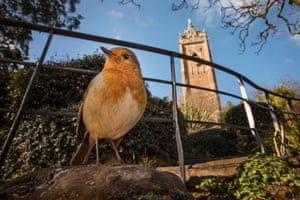Each morning BBC presenter Chris Packham livestreams wildlife from around his farmhouse in the middle of the New Forest. It’s a bucolic setting – surrounded by trees smothered in ivy, primroses and old hedgerows. One of his pleasures is sitting under a hedge and listening to a robin sing. “It’s just an eruption, an incredible drive to produce this cascade of notes to say this is my space and my time and I’m going to prosper. It’s really pumping it out, it’s a fabulous natural concert and it’s available to everyone,” he says.
Packham, who has created the self-isolation bird club with his step-daughter, zoologist Megan McCubbin, can see marsh tits, greenfinches, great tits and chaffinches on his bird feeder. “All of this wildlife is quite literally on my doorstep. This is an opportunity – and we need to be finding opportunities in this chaos – to reconnect with nature,” he says.
Lockdown is a chance to get to know the natural world that surrounds us, and notice its abundance – even in the most familiar places.
Q&A What is wild cities week?
Show
Hide
This week, the Guardian’s Age of Extinction site is looking at biodiversity in cities and urban areas around the world, shining a spotlight on the under-appreciated world of nature hidden among the highrises and busy roads.
Around 55% of the world’s population live in urban areas and that number is projected to rise to 68% by 2050. Nature’s role in the wellbeing and happiness of billions of people will be more important than ever. While urbanisation is a major driver of biodiversity loss, many conservationists and town planners are trying to make built-up areas more nature-friendly. The role of green spaces in urban areas has even been formalised in a draft UN agreement to halt and reverse biodiversity loss, often referred to as the Paris agreement for nature.
The Covid-19 outbreak has seen cities and towns across the world go into lockdown which has enabled wildlife such as wild boar, deer, monkeys, foxes and even lions to venture into territory previously dominated by humans. It has also offered us the chance to notice and appreciate the natural world in cities in an unprecedented way.
In this special series of reports we’ll be looking at how animals and plants adapt to city life, what to look out for right now and how we can encourage more wild cities in the future.
It could be a plant peeping through pavement cracks, a moth fluttering around a bulb in the bathroom or the sound of birds screeching overhead during the spring migration.
Even city-dwellers, whose skies are filled with pigeons, have the chance to become armchair ornithologists. These birds – whose wild ancestors are cliff-dwelling rock doves – have an interesting repertoire of behaviours that people often overlook, says Packham, who describes them as a “delight” to watch.
Males court females by puffing up their breast, putting their head down, fanning their tail and following them around in circles. “All natural behaviours for rock doves but you don’t need a telescope or binoculars because it is quite literally happening under your feet. For students of bird behaviour, or people just getting into it, this is the time to take advantage of that,” he says.
The problem is people don’t like successful animals, says Packham. “It doesn’t matter if it’s a rat, a cockroach or a pigeon. They live alongside us and they prosper and rather than celebrate it, we get resentful and think there are too many of them.” For anyone not convinced by the merits of pigeons, they are the main part of the urban peregrine falcon diet, which the BBC presenter describes as “unquestionably one of the sexiest organisms on the planet”, so that’s another reason to be grateful for them.
There is a lot more to urban birdwatching than pigeons, says David Lindo, also known as the Urban Birder, who has spotted ring ouzels, swifts, bramblings and hobbies in London in the past 12 months. “London has an amazing diversity of birds. Even in the middle of a real concrete jungle area you can still see things – it’s a challenge,” says Lindo, who first got into urban birding because he had no one to take him out to the countryside.
Lindo is currently self-isolating in the Spanish city of Merida in Extremadura. From his sun terrace he can spot 20 species in an hour, including six types of bird of prey. “It’s just great to see short-tailed eagles gliding across, or to look up and see a massive black vulture – I love it,” he says.
As well as looking up, people must look down, says London-based botanist Dr Mark Spencer, who believes people should get on their hands and knees to look at unglamorous plants (he doesn’t like the term “weed”) peeping through cracks in the ground.
To get a better view of modest plants sprouting around the home, Spencer encourages people to buy a x10 magnifying hand lens, which costs about GBP5. They make small, innocuous-looking plants look much more interesting. “It opens up a new and incredibly beautiful world. Things like hairs on leaves become quite extraordinary, and people don’t notice these things. A hand lens is a great way of shifting your perception of what’s in front of you,” he says.

In spring, the natural world is perhaps at its most beguiling during the hours of darkness, when billions of birds are migrating into the northern hemisphere. Because people aren’t able to spend their evenings in the pub or the cinema, more than ever are sitting outside listening to this natural phenomenon.
The great bird migration began with common scoter ducks flying over the UK in early April. According to the Bird Guides website, the number of reports received on the night of 1 April was unlike anything seen before in UK birding history.
“At least 60 sites, the vast majority in Lancashire, Yorkshire and Northumberland, logged the species, with some localities reporting that multiple flocks were passing over on a near-constant basis for extended periods of time during the night,” the website reads.
So many people reported hearing the birds, researchers could track the exact route of the migration as it made its way across the country. Using this data, Alexander Lees, a senior lecturer in conservation biology at Manchester Metropolitan University, is looking to write a paper charting migration corridors. “We’ve been able to map the overland migration route of these birds for the first time ever essentially – it’s been incredible,” he says.
Quick guide What is citizen science?
Show
Hide
Citizen science is research performed by non-scientists, usually members of the public. It has led to numerous discoveries, from new planets and animal species to insights on coral reef restoration and butterfly populations. Nasa, the Natural History Museum and even the US government are among the many organisations that ask members of the public, including children, to help collect data, interpret results and solve research problems for scientific projects.
Citizen science plays a vital role in monitoring plant and animal populations around the world, often through mobile phone applications. iNaturalist, a joint initiative between the California Academy of Sciences and the National Geographic Society, allows users to photograph and identify plant species around the world, informing scientific research. Nearly 35m observations of 269,859 species have been uploaded to the platform in towns, cities and rural areas from every continent.
Yes. Whether you are documenting the organisms you see during your daily hour of exercise or just recording what you see from your window, the biodiversity you document will further scientific research. While stuck at home, you could even help scientists count penguins in Antarctica, monitor global seal populations or record large mammal sightings in Gabon.
Zooniverse lists several projects you can help with that are not just limited to biodiversity.
The Wildlife Trusts is asking for volunteers on citizen science projects.
iNaturalist, eBird and Tree ID are among the hundreds of citizen science phone applications for biodiversity available.
Other birds such as quail, terns, sand martins, chiffchaffs, swallows, warblers and cuckoos, are among those doing the spring migration. Most migrate at night to avoid predators, and in the cooler air they use less energy. “If these birds arrived during daylight hours people would be just aghast at what’s happened. A sky full of birds,” says Lees.
As well as birds, moths are also most active at night and there is no need for a moth trap to see them. Leaving a light on in a room and opening a window (close the door so they don’t fly into the rest of the house) or leaving the porch light on should attract them. Moths such as the large yellow underwing, silver Y moth and hummingbird hawk moth are widespread, visible in urban as well as rural areas.
There are 2,500 species of moth in the UK. July and August are peak times but they will already be out in spring. “When the weather is warm in summer, you can bring in hundreds of moths … It’s a good idea to start at this time of year and ease yourself into it. It’s a bit scary when you get 200 moths in a trap at once,” says Dr Emma Coulthard, a lecturer in ecology at Manchester Metropolitan University, who encourages the public to log their findings via the Garden Moth Scheme.

As the lockdown in the UK continues, nature-watching in its cities and the countryside should only get better. Despite the catastrophic impacts of coronavirus, the great British garden, whether a tiny inner-city space or sprawling rural plot, could be at its best for years.
“All those gardeners, those green-fingered folk, will have time on their hands,” says Packham. “I imagine our gardens will blossom, they will probably be at their best by the end of this summer, because people will have time and they’ll be out there tending to stuff.”
Five tips for photographing wildlife on your doorstep
Sam Hobson is an award-winning wildlife and conservation photographer based in Bristol and best known for his work with urban wildlife. He shares his top tips for capturing great wildlife pictures.

For those of us with time on our hands during lockdown, the enforced slowing down is a real opportunity to reconnect with nature and discover the wildlife on our doorsteps. Often, we’re too busy to stop and notice, but when we slow down, we can tune in to nature and start to notice what’s been there right under our noses all along.
Even if we have no space but a window ledge, growing plants, watering and nurturing them and watching as they flower and start to attract insects can lift the spirits, while bringing peace and tranquillity to your space – and of course it’s the perfect opportunity to develop your wildlife photography skills and take some great pictures.
1. Enjoy it!
The best wildlife photographers are people who do it for the pure joy of it – not to win awards or for social media likes. Doing something purely for yourself and not being motivated by the approval of others can be so much more enjoyable! It doesn’t matter what camera kit you’ve got or how rubbish your pictures are if they are just for you.

2. Become a wildlife photojournalist
Documenting a story is a great way to bring a narrative to your pictures. You could try to photograph and identify every insect you find in your garden, or simply document the growth of the plants and flowers. Looking back at a set of pictures taken over weeks is a great way to appreciate how quickly things change at this time of year. Perhaps make a lockdown diary or go on a back garden bug safari with your children and start a garden wildlife lockdown list.
3. Start a species project
Focusing on a particular species is a great way to create an exciting gallery of images. Really paying attention to just one species is the best way to learn about its habits and behaviour, and develop your wildlife photography skills. Every time you take a picture of a subject, you automatically look for new ways to do it: a new angle, better lighting or perhaps an action shot.
4. Champion the underdog
Following on from the previous tip, don’t get hung up on trophy-hunting the sexy species! The less glamorous the animal, often the better the photographic opportunities – likely the ones ignored by other photographers. You don’t need to travel across the world to photograph elusive wildlife – I have won awards with pictures of local pigeons, gulls and foxes. Even if you can only find slugs in your garden, you can still get creative!

5. Let it come to you
Opportunistic pictures are the most difficult to take; getting the camera out in a rush and trying to get a good picture before something disappears can be frustrating – and can make us miss an exciting wildlife encounter entirely. My best pictures come from observation and planning. For example, if you know that bees keep returning to a particular flower, or birds are regularly coming to a feeder, you can lie in wait and be ready with your camera when the next one returns. Wildlife is particularly bold at the moment as there are fewer people on the streets and the reduced noise means animals can better listen out for danger. You might be able to attract something not usually found in your area like a hedgehog or fox by leaving out some treats in your garden (it’s easy to research online what is responsible and appropriate if you’re planning to feed something).
Find more age of extinction coverage here, and follow biodiversity reporters Phoebe Weston and Patrick Greenfield on Twitter for all the latest news and features